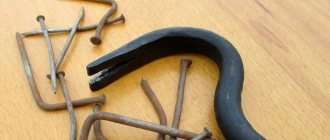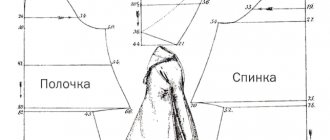Despite the apparent simplicity of the design, the holding device for the electrodes (holders) is a critical component. It must meet certain requirements:
- Reliable dielectric protection of the operator;
- Thermal insulation of the handle;
- High-quality wire fastening for the welding machine;
- Ability to withstand currents measured in hundreds of amperes;
- Strong grip of the electrode;
- Easy replacement of the cinder with a new electrode.
The last two points actually contradict each other, so the design of the electrode holder is always a compromise. Professional welders never stop arguing about the advantages and disadvantages of certain holder designs.
We will look at both factory-made and home-made electrode holders.
Factory made holders
- Collet; Quite a convenient option. Replacing the cinder with a new electrode is effortless. Looks aesthetically pleasing. Advantages : ergonomic handle, excellent protection of the welder from temperature and electrical influences. The disadvantage is the high cost and restrictions on the maximum welding current. Do not leave a short stub - there is a high probability of damaging the handle.
- Clothespin; The most common factory design. Available in a variety of sizes, for any welding currents and electrode diameters. It’s not very convenient due to the protruding lever, but the reliability makes up for the ergonomic shortcomings. Advantages - there are practically no current restrictions, very reliable contact with the electrode, no additional equipment is required to change the cinder. The disadvantage is the bulky design; installing a new electrode requires a lot of force.
- Fork (trident). The most famous and popular option, especially for welders of the old Soviet school. At the same time, it is the most controversial design. Today it is not available for sale; only old copies can be found on the secondary market. The reason is prohibited by safety standards due to the high probability of getting radiation burns to the eyes. Advantages : phenomenal simplicity of design. Disadvantages : high incidence of injuries, poor contact with the electrode, additional equipment is required to remove the cinder.
Video on making a tube
I also recommend watching a video on making a tube for electrodes.
The container turned out great! Everything is very durable and convenient and easy to use! I advise you to make the same one for yourself, especially since it’s very easy to do!
And that's all for me! Thank you all very much for your attention and see you next article!
Source
Homemade designs
Trident
This is simply a welding classic. There is hardly an electric welder who has not held in his hands a “fork” welded from three pieces of corrugated fittings. A piece of rubber hose or a handle from a bicycle handlebar was usually used as a dielectric handle. Sometimes they just made do with rag tape.
The option is the simplest to manufacture, however, it is quite inconvenient and dangerous during operation. The biggest problem is removing the cinder. Due to the design features, the electrode was used almost completely - this was always presented as one of the advantages.
In this case, the cinder was removed using a hammer or pliers. You've probably seen more than once a picture of a welder pounding a holder on the asphalt, knocking out the remaining electrode from it. Another disadvantage is poor contact.
Typically, welders attributed a failed weld to “bad electrodes”; in fact, the loss of current is caused by rusty oxides on the surface of the reinforcement. Therefore, a file for stripping is an invariable companion of such a device.
A more advanced option is a rod welded to a metal corner.
This design is more reliable, the electrode is held firmly and the electrical contact is good. There is only one drawback - it is still difficult to replace the cinder with a new electrode.
Trident with spring
Upgraded version of the previous model
This design is made from high-quality steel, preferably stainless steel, to ensure reliable contact. The central finger springs the electrode, which makes changing the cinder somewhat easier.
The design, as well as the materials used, are clearly visible in the figure.
There is only one drawback - expensive materials (stainless steel). At the same time, the cost price is significantly lower than a factory product.
How to make a homemade holder with a spring is detailed in this video.
Collet (threaded) version
The design is reliable and easy to use. There is only one drawback - troublesome production. The technology of the product can be seen in the drawing.
You can make such a holder with your own hands from any metal. The main thing is reliable contact of the welding cable.
Collet (clamping) version
Technical development of the previous version of the holder. Instead of a threaded connection, a spring clamp is used. The obvious advantages of the design are the ease of changing the cinder to a new electrode. Again, a compromise option. The more powerful the spring, the more force is applied to replace the electrode.
But at the same time, the reliability of the contact, and therefore the maximum current value, increases. Conversely, operating comfort reduces the current load. No less important is the second connector, which supplies current to the welding object - ground.
It does not need to provide thermal and electrical protection. But the contact must be extremely reliable. Otherwise, due to resistance, the current strength decreases and welding efficiency decreases. It is best to choose a copper or brass clamp. The cable attachment should be as close as possible to the point of contact with the metal.
If there is sparking at the place where the earth clamp is attached, in addition to current loss, you can get stuck to the workpiece. This will ruin both the clamp and the metal being processed.
Read also: Jack press for juice
During operation, it is often necessary to move the holder a long distance from the transformer. In order not to limit yourself too much in distance, there are extension cords for both the supply and working cables. A welder's power extension cord is not much different from a regular one. Several requirements are taken into account. Operating current is not lower than 25 Amperes.
Heat-resistant flexible insulation. Reliable plugs and sockets, preferably with a mating lock. If we are talking about a work cable extension, then its cross-section should not be smaller than the main wires. The connection method is also special - special bayonet connectors are used.
Then current losses in the connectors are eliminated.
And this video explains in detail what to look for when choosing a holder for a welding machine.
For a professional welder, and even for an amateur, a good electrode holder is the key to comfortable and convenient welding. When purchasing a holder, you need to know how to choose a much-needed item for welding work, what points you need to pay special attention to, so that later problems do not arise when using it.
The process of manufacturing a trolley for a semi-automatic machine
After preparing all the necessary materials, you can begin the assembly process. For convenience, it is worth examining each step in more detail:
- Step 1 . At the first stage, the base is assembled. To do this, you need to bend the profile on a pipe bending machine. After this, all the elements necessary for assembling the base are cut. It is important that everything is done for a specific cylinder and equipment.
- Step 2 . Axles for future wheels are welded to the resulting base. To do this, long bolts are used, which are subsequently welded to the frame. It is worth remembering that the wheels must be of sufficient diameter, at least 20 mm. This is necessary so that the cart can move easily on the ground.
- Step 3 . In order for the cylinder to be attached to the structure, you need to weld a fork from a pipe. In the future, the cylinder will be secured using tight clamps.
- Step 4 . At this stage, all the necessary shelves are welded from pipes. It is best to use corrugated aluminum as cladding, which not only has high strength values, but also has an excellent appearance.
- Step 5 . Using a vice, the reinforcement is bent into arcs, which will later be used to strengthen the shelves.
- Step 6. Wheels are placed on the axle; if necessary, you can equip the structure with maneuverable wheels that will rotate 360 degrees.
Reference! It is best to use wheels like garden carts.
Once the assembly is complete, you can paint the cart and give it a more aesthetic appearance.
Manufacturing nuances
What can be attributed to the main nuances of making homemade products:
- the cross-section of the pipes must be at least 40x20, and the wall thickness must be at least 1 mm;
- the wall thickness of the corner must be at least 1 mm;
- The thickness of the sheet metal must be at least 1.5 mm.
The table shelves, as well as additional equipment, are made of corrugated aluminum or sheet steel and plywood. In this case, there should be a rubber coating on top. It is important to remember that the thickness of the aluminum sheet must be at least 2 mm, and the thickness of the plywood must be at least 5 mm.
Also, the user must immediately indicate the number of transported cylinders, because the size of the trolley directly depends on this.
Device
Let us briefly consider the design of the electrode holder. Several important factors depend on the design of the device:
- quality of welded joints;
- master's labor productivity;
- convenience and safety of work.
inexpensive electrode holder
A standard type holder is a tool consisting of several parts: body, clamp, handle, moving parts. But different species may have some structural features . More details below.
Let us briefly consider what types of electrode holders exist. Electrode holders are divided into universal and specialized . The production of both groups is regulated by GOST standards. For homemade ones, see the separate subheading below.
The universal electrode holder is the most popular, as it allows welding in various spatial positions.
There is also a more detailed classification:
1. Clamping clothespin holder (spring or lever) is characterized by a simple design and low price. The main disadvantage is weak fixation of the electrode.
This type can be made in two modifications:
- simple is compatible with most types of welding machines and the complete absence of non-insulated areas;
- automated ensures high seam quality, significant energy saving and automatic arc ignition.
2. Screw electrode holders allow the cathode to be firmly fixed. The main disadvantage is the need to constantly unscrew and tighten the screw in the clamping device when changing the material for welding.
We suggest watching a video where the user compares two holders, a screw one and a clothespin, and makes a choice in favor of the screw one.
3. The design of non-flammable is designed in this way: the electrode is not fixed with a clamp, but is welded to the end of a rod with an insulated surface and completely melts during the joining process. Then the next rod is taken.
4. Quite popular among welders of any level is the trident fork . However, this type, made in a simple modification, poses a serious threat to the health of the master due to the large number of unprotected parts.
Homemade fork holder
5. The collet holder is used in argon arc welding torches.
6. The electrode holder with a rotary type clamp allows you to quickly and reliably fix the rod at only one angle.
In addition to the above types, there are also special-purpose units that are used to create a certain type of seam.
Communities › DIY › Blog › Electrode case!
Hi all! Often you have to work with welding at home. I don’t know what it’s like for anyone, but it often happens to me that I don’t have an electrode at hand. Even before New Year’s Eve, I decided to make myself a useful thing out of scrap metal.
Comments 37
I have 2 pencil cases) one is from a container of polyurethane foam, in it I carry eyelets (for potholders) and a cleaver with a square, and the second for wands) is the plastic one in which they are sold)
wheels are missing
I cook a lot, but I haven’t even thought about such a coffin... A leather quiver for 1 kg of electrodes is enough for my eyes. And then for working at heights, so as not to jump after them. In all other situevins there is one in the holder and 2-3 pieces in the hand, the rest is nearby in a pack.
if you do, then use a sealed box (as much as possible). Otherwise, they get damp











